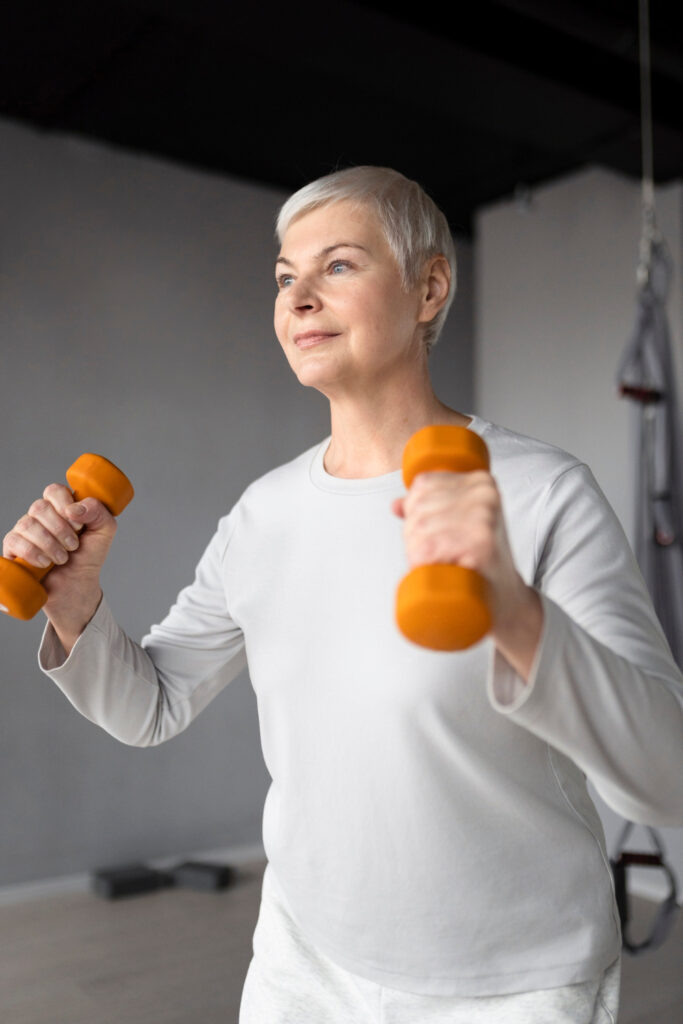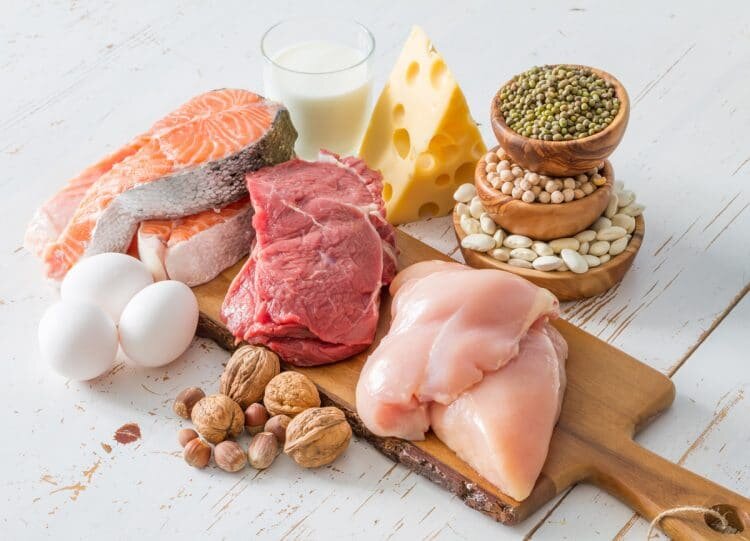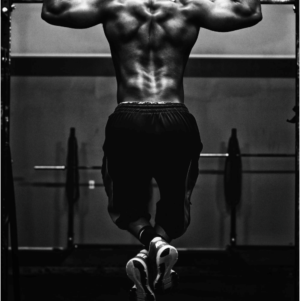Think the opportunity to gain muscle mass disappears after 50? Rethink that statement! We present strategies that should be applied to maintain strength and muscles even in the later stages of life.
Gaining Muscle Mass After 50.
Strength training, bodybuilding, and powerlifting are often associated with the age range of 20 to 30. And, let’s be honest, things like bicep size, a defined abs, or a one-rep max bench press record seem more important when you’re young.
People over 50 are often more interested in maintaining health, weight control, regulating blood pressure and cholesterol, as well as preventing age-related pains. However, strength training not only remains important with age but also contributes to extending an active lifestyle.
Forget about lifting weights just for the sake of appearance, although that’s also beneficial even if you’re over 50. Gaining muscle mass improves various aspects of your physical condition and slows down the aging process!
In this article, we will explore the key benefits of gaining muscle mass after 50, share strategies, and provide a workout program. Additionally, we’ll answer your frequently asked questions about strength training after 50.

Benefits of Gaining Muscle Mass After 50.
Human nature tends to lean towards laziness. But this isn’t necessarily a bad thing, as laziness and the desire to conserve energy have driven many technological achievements and conveniences we enjoy today.
We use motorized transportation instead of walking, tap water instead of well water, electric lighting instead of fire, and supermarkets instead of hunting and gathering. In general, life has become much more comfortable.
However, this laziness leads to a sedentary lifestyle, and many people struggle to find motivation for regular physical exercise. Therefore, understanding the benefits of workouts becomes especially important.
Understanding the benefits of physical exercise provides additional motivators to maintain a regular workout routine. Knowing WHY you engage in sports can be a powerful incentive. The next time the temptation to skip a workout arises, just remember all the benefits you’ll miss out on:
- Preserving Muscle and Strength: Muscle mass naturally peaks in the mid-30s and decreases by 3-8% every ten years thereafter. This process, known as sarcopenia, explains why older people often feel less strong. Regular strength training can slow down the rate of muscle mass loss and help restore lost muscles.
- Weight Management: As muscle mass decreases with age, fat mass increases. This leads to an expansion of the waistline and weight gain. Gaining muscle mass can help maintain weight or lose fat, as muscles burn more calories, contributing to an active metabolism.
- Increased Bone Mass: Strength training contributes to muscle and bone strengthening. When muscles pull on tendons, they impact bones and periosteum, stimulating bone growth. This can help prevent osteopenia and osteoporosis, improving overall strength and reducing the risk of fractures.
- Stable Blood Glucose Levels: Strength training enhances glucose utilization, helping control blood sugar levels. This is particularly important for preventing chronically elevated glucose levels, which can lead to various conditions, including diabetes, obesity, and heart problems.
Knowing these benefits underscores the importance of including strength training in a regular exercise routine to maintain overall physical health and viability throughout life.
More Mobile and Stable Joints
As people age, many face joint pains caused by the natural wear and tear of knees, hips, and shoulders. These discomforts can deter regular workouts, but building muscle mass can alleviate pain and prevent its exacerbation. Strong muscles can stabilize joints, preventing excessive movements and relieving the load on bones. Additionally, increased strength facilitates everyday actions such as walking, lifting weights, and movement, reducing pressure on joints

Many muscle-building exercises also contribute to improved joint mobility and can reduce pain [5]. Squats, lunges, pulls, and push-ups, for example, enhance mobility by strengthening relevant muscles.
While it may be necessary to adapt the workout program based on the condition of your joints, building muscle mass usually has a beneficial impact on joint condition and functionality. It’s crucial to remember that joints become weakened and less mobile due to a lack of movement, not physical exercise. Keep them active to maintain their health.
Enhancing Neurological Function
If the muscles and bones of your body are the hardware, your nervous system is the software. Strength training influences the nervous system, improving its function. Benefits for the nervous system include better balance, enhanced coordination, and increased proprioception [7].
Improved neurological function facilitates movement, enhances daily activity, and reduces the risk of falls, which is a significant concern for the elderly.
Improving Mental Health
Strength training has a positive impact not only on physical but also on mental health. Regular workouts can significantly affect various aspects of mental health, including improved memory, creativity, problem-solving abilities, reduced risk of depression, anxiety, and stress, as well as creating a more positive health outlook. Mental and physical health are interconnected, and building muscle mass contributes to their mutual improvement.
Maintaining Better Posture
Good posture, i.e., the correct position of joints, is a key element in minimizing the load on bones and muscles. Lifting weights is an excellent way to strengthen muscles that support proper posture. Exercises for the back, buttocks, hamstrings, and upper back are particularly important for correcting stooping.
With age, posture may deteriorate, leading to changes in the center of gravity and an increased risk of falls. Maintain good posture through workouts to look and feel younger, as well as to reduce the risk of injuries.
Improving Cardiovascular System and Overall Health
Even if you believe that cardio is necessary to improve cardiovascular health, strength training also has a favorable impact. Lifting weights involves periods of intense work followed by short rest periods, characteristic of interval training known for its cardio effects.
Compound exercises like squats, bench presses, and bent-over rows engage multiple muscles, requiring additional oxygen. This increases heart rate and respiratory activity, despite not being a typical cardio workout.
Thus, building muscle mass is a multifaceted and effective approach to maintaining health, especially after 50. Use these benefits as additional motivation for regular workouts. Remember that before starting a new workout plan, especially for older individuals, it’s important to consult with a physician.
Recommendations for Building Muscle Mass After 50:
Translate into American English:
- Choose complex compound exercises:
- Fundamental exercises engaging multiple muscles and joints provide the greatest benefits.
- Compound exercises are generally more functional and effective.
- Select exercises you enjoy:
- Enjoyable exercises contribute to consistent workouts.
- Pleasure from exercises is crucial for maintaining workout consistency.
- Perform at least 10 sets for each muscle group per week:
- Distribute sets across multiple workouts throughout the week.
- Use a split routine or full-body workouts.
- Train 2-4 times a week:
- Rest is crucial for recovery, especially after the age of 50.
- 2-4 workouts per week strike a good balance between stress and rest.
- Lift weights with high repetitions:
- Research shows that light weights and high repetitions are also effective.
- This may be more suitable for mature individuals and those with limitations.
- Warm up thoroughly:
- Dedicate 10-20 minutes to warm up before exercising.
- Include light cardio and dynamic mobility exercises.
- Maintain proper exercise technique:
- Correct technique minimizes the risk of injury.
- If you have questions about technique, consult a trainer.
- Pay attention to recovery:
- Age requires more time for recovery; prioritize it.
- Include regular rest days in your program.
- Gradually increase intensity:
- Start with moderate loads and gradually intensify workouts.
- Listen to your body and avoid overtraining.
- Monitor nutrition and sleep:
- Healthy eating with sufficient protein is crucial for muscle growth.
- Ensure adequate sleep for optimal recovery.
Remember, before starting a new workout plan or making changes to an existing one, it’s best to consult with a doctor, especially if there are any medical contraindications or restrictions.
Prioritize mobility and flexibility:
- With age, muscles and joints become less mobile and more rigid, making exercise challenging.
- Regaining lost flexibility and mobility is possible through regular stretching at any age.
- Daily stretches maintain flexibility and ease of movement, preventing stiffness and discomfort.
Consistency is key:
- Breaks in workouts lead to a decrease in strength and muscle mass.
- Even small but regular weekly workouts help preserve muscle mass after the age of 50.
- Consistency is the key to successful muscle building, even with shorter workouts.
Respect your body’s need for rest and recovery:
- As you age, the need for rest and recovery increases.
- Full sleep (7-9 hours) and periodic breaks from physical activity are necessary for effective recovery.
- Respecting your body’s need for rest supports muscle preservation and growth.
Emphasize protein intake:
- For muscle building, a caloric surplus and nutrient-rich diet are essential.
- Protein sources like eggs, chicken, fish, legumes, and nuts provide amino acids for muscle building.
- Maintaining a positive protein balance, with around two grams of protein per kilogram of body weight, promotes recovery and muscle growth.
Not just weights:
- Balanced approach: Strength training and muscle building are important, but balance them with cardio workouts and activities that promote brain health. Avoid excessive TV sitting, as it does not contribute to longevity.
- Additional activities: Incorporate into your life:
- Walks and hikes,
- Swimming,
- Cycling,
- Traveling,
- Learning new skills,
- Artistic or creative activities,
- Reading and socializing. These activities help prevent aging and support overall health.
Acknowledge your limitations:
- Accepting change: Despite the importance of strength training, it cannot stop the aging process. Age-related changes in physical abilities are inevitable. It’s important to acknowledge your limitations and adapt workouts to age-related changes, avoiding attempts to replicate a workout plan from youth.
- Focus on the present and future: Focus less on past achievements and more on what you can and want to do in the future. Concentrate on attainable achievements in the present to maintain a positive attitude toward workouts.
Start slow, build momentum:
- Gradual engagement: Begin with light workout programs and gradually increase the load. Train regularly for several months to allow your body to adjust to the workout stress.
- Establish sustainable habits: Automate workouts to fit your lifestyle. Create a workout plan that easily integrates into your routine, making exercise a part of your daily life.
- Consistency is crucial: Success depends on consistency. Create a long-term workout plan that is easy to maintain. Gradually increase intensity to make workouts consistent and effective.
Workouts after 50: Detailed Plan and Answers to Questions Now, armed with all the necessary information to create your own workout plan after 50, you can invest time and effort into its development. However, to make your task easier, we provide a ready-made program covering all muscle groups, designed to be performed 2-3 times a week on non-consecutive days, such as Monday, Wednesday, and Friday. This program, tailored for individuals 50+, is designed for muscle building and improving function without additional stress on your joints. Follow it for 2-3 months, transitioning to a more advanced program when you feel ready. Remember the importance of a thorough warm-up before workouts.

Workout Program:
- Reverse Lunges:
- 2-3 sets of 12-20 repetitions per leg
- Rest between sets: 60-90 seconds
- Incline Dumbbell Press:
- 3-4 sets of 12-20 repetitions
- Rest between sets: 60-90 seconds
- Wide-Grip Seated Lat Pulldown:
- 3-4 sets of 12-20 repetitions
- Rest between sets: 60-90 seconds
- Single-Leg Romanian Deadlift:
- 2-3 sets of 12-20 repetitions per leg
- Rest between sets: 60-90 seconds
- Seated Dumbbell Shoulder Press:
- 3-4 sets of 12-20 repetitions
- Rest between sets: 60-90 seconds
- Seated Cable Row to Waist:
- 3-4 sets of 12-20 repetitions
- Rest between sets: 60-90 seconds
- Goblet Squats:
- 2-3 sets of 12-20 repetitions
- Rest between sets: 60-90 seconds
- Plank:
- 3-4 sets of 20-40 seconds
- Rest between sets: 60-90 seconds
- Pallof Press:
- 3-4 sets of 12-20 repetitions per side
- Rest between sets: 60-90 seconds
- 45-Degree Back Extension:
- 3-4 sets of 12-20 repetitions
- Rest between sets: 60-90 seconds
Frequently Asked Questions:
- How much muscle can be built after the age of 50?
- The amount of muscle that can be built after 50 depends on various factors, including current muscle mass, body type, workout history, diet, and motivation. Focus on real goal achievements rather than predictions.
- What diet is best for people aged 50 and above?
- The best diet for muscle building and overall health is one that provides all necessary nutrients and calories, based on whole or natural foods. The Mediterranean diet is considered one of the healthiest.
- Can I modify exercises in the workout program?
- You can make changes to exercises as needed while maintaining the overall balance of the program. For example, replace an exercise with a similar level of intensity.
- Can I train every day?
- Training for muscle building after 50 involves full-body workouts, requiring time for recovery. It is recommended to train every other day, allowing muscle groups time to recover. However, a little complete rest per week can also be beneficial.
- How to choose weights for muscle building workouts after 50?
- Determining the right weight for workouts after 50 is an individual task. Experiment to find a weight that brings your muscles close to failure within 12-20 repetitions. The optimal weight keeps you in the range of 12 to 20 repetitions.
- Are there useful supplements for muscle building after 50?
- Muscle building after 50 is possible without supplements. However, certain substances can accelerate muscle growth or enhance recovery. These include protein, creatine, pre-workout complexes, caffeine, ZMA, melatonin (for improved sleep), BCAAs, and EAAs.
- Can I continue weight training after 60 and even later?
- Yes, not only can you but you should continue weight training as long as possible. The “use it or lose it” principle means that ceasing workouts leads to muscle loss and reduced strength. Adapt your approach as you age, but persistence in maintaining muscle activity and effort in workouts is key to preserving health and muscle mass.
Final Thoughts: Building muscle mass is possible at any age, including after 50. While physiological processes slow down with age, with effort and dedication, one can become stronger and more muscular even in middle age. Many athletes, including those over 50, demonstrate impressive results. Use the information provided in this article to continue thriving, regardless of your age.
Sources:
- Chang SF, Lin PL. A systematic review and meta-analysis of the association between sarcopenia and mortality. Worldviews Evid Based Nurs. 2016 Apr;13(2):153-62. doi: 10.1111/wvn.12147. Epub 2016 Feb 4. PMID: 26844538.
- Hiol AN, von Hurst PR, Conlon CA, Mugridge O, Beck KL. The association of body composition with muscle strength in older adults living in Auckland, New Zealand. PLoS One. 2021 May 28;16(5):e0250439. doi: 10.1371/journal.pone.0250439. PMID: 34048458; PMCID: PMC8162602.
- Massini DA, Nedog FH, de Oliveira TP, Almeida TAF, Santana CAA, Neiva CM, Macedo AG, Castro EA, Espada MC, Santos FJ, Pessôa Filho DM. Influence of strength training on bone mineral density in elderly individuals: a systematic review and meta-analysis. Healthcare (Basel). 2022 Jun 17;10(6):1129. doi: 10.3390/healthcare10061129. PMID: 35742181; PMCID: PMC9222380.
- Jiahao L, Jiajin L, Yifan L. The effects of resistance training on insulin sensitivity in elderly individuals: A meta-analysis of randomized controlled trials. J Exerc Sci Fit. 2021 Oct;19(4):241-251. doi: 10.1016/j.jesf.2021.08.002. Epub 2021 Aug 19. PMID: 34552636; PMCID: PMC8429971.
- Latham N, Liu CJ. Strength training in older adults: the benefits for osteoarthritis. Clin Geriatr Med. 2010 Aug;26(3):445-59. doi: 10.1016/j.cger.2010.03.006. PMID: 20699165; PMCID: PMC3606891.
- Mayer F, Scharhag-Rosenberger F, Carlsohn A, Cassel M, Müller S, Scharhag J. Intensity and duration of resistance training for the improvement of metabolic health in ageing adults-a systematic review and meta-analysis. Dtsch Arztebl Int. 2011 May;108(21):359-64. doi: 10.3238/arztebl.2011.0359. Epub 2011 May 27. PMID: 21691559; PMCID: PMC3117172.
- Lee IH, Park SY. Improvement of balance with resistance exercise in elderly individuals. J Phys Ther Sci. 2013 Dec;25(12):1591-3. doi: 10.1589/jpts.25.1591. Epub 2014 Jan 8. PMID: 24409027; PMCID: PMC3885846.
- Li Z, Peng X, Xiang W, Han J, Li K. The effects of resistance training on cognitive function in the elderly: a systematic review of randomized clinical trials. Aging Clin Exp Res. 2018 Nov;30(11):1259-1273. doi: 10.1007/s40520-018-0998-6. Epub 2018 Jul 13. PMID: 30006762.
- Baz-Valle E, Fontes-Villalba M, Santos-Concejero J. Total Number of Sets as a Quantitative Method to Measure Training Volume for Muscle Hypertrophy: A Systematic Review. J Strength Cond Res. 2021 Mar 1;35(3):870-878. doi: 10.1519/JSC.0000000000002776. PMID: 30063555.
- Lasevicius T, Ugrinowitsch C, Schoenfeld BJ, Roschel H, Tavares LD, De Souza EO, Laurentino G, Tricoli V. The Effects of Different Intensities with Equated Volume Load on Muscle Strength and Hypertrophy. Eur J Sport Sci. 2018 Jul;18(6):772-780. doi: 10.1080/17461391.2018.1450898. Epub 2018 Mar 22. PMID: 29564973.*


